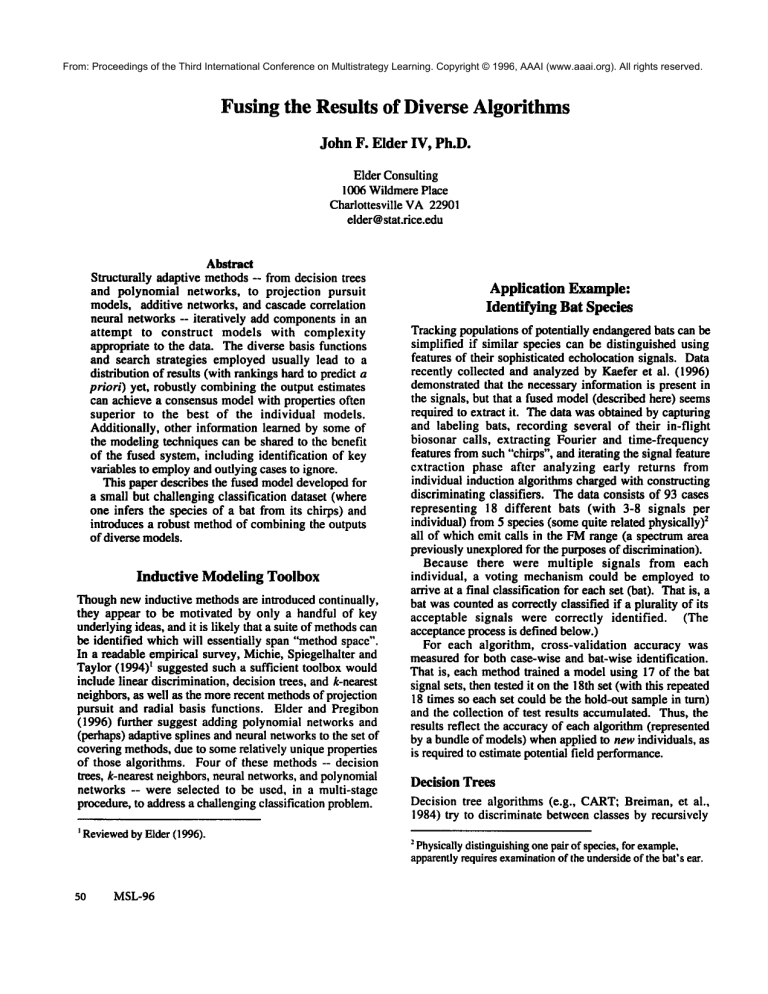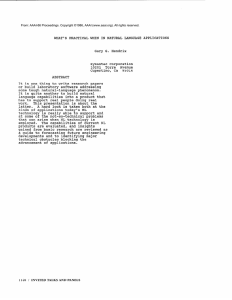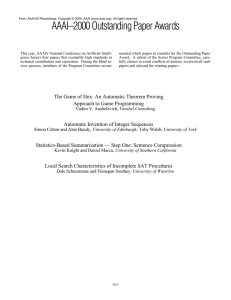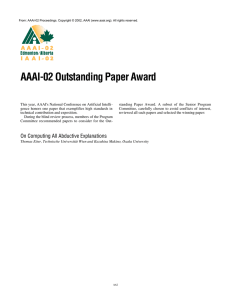
From: Proceedings of the Third International Conference on Multistrategy Learning. Copyright © 1996, AAAI (www.aaai.org). All rights reserved.
Fusing the Results of Diverse Algorithms
John F. Elder IV, Ph.D.
Elder Consulting
1006 WildmerePlace
Charlottesville VA22901
eider@stat.rice.edu
Abstract
Structurally adaptive methods-- from decision trees
and polynomial networks, to projection pursuit
models, additive networks, and cascade correlation
neural networks -- iteratively add componentsin an
attempt to construct models with complexity
appropriate to the data. The diverse basis functions
and search strategies employed usually lead to a
distribution of results (with rankings hard to predict
priori) yet, robustly combiningthe output estimates
can achieve a consensus model with properties often
superior to the best of the individual models.
Additionally, other information learned by some of
the modelingtechniques can be shared to the benefit
of the fused system, including identification of key
variables to employand outlying cases to ignore.
This paper describes the fused modeldeveloped for
a small but challenging classification dataset (where
one infers the species of a bat from its chirps) and
introduces a robust methodof combiningthe outputs
of diverse models.
Inductive Modeling Toolbox
Thoughnew inductive methods are introduced continually,
they appear to be motivated by only a handful of key
underlyingideas, and it is likely that a suite of methodscan
be identified which will essentially span "methodspace".
In a readable empirical survey, Michie, Spiegelhalter and
Taylor (1994)t suggested such a sufficient toolbox would
include linear discrimination, decision trees, and k-nearest
neighbors, as well as the morerecent methodsof projection
pursuit and radial basis functions. Elder and Pregibon
(1996) further suggest adding polynomial networks and
(perhaps) adaptive splines and neural networksto the set
covering methods, due to somerelatively unique properties
of those algorithms. Four of these methods -- decision
trees, k-nearest neighbors, neural networks, and polynomial
networks -- were selected to be used, in a multi-stage
procedure, to address a chaUengingclassification problem.
Application Example:
Identifying Bat Species
Tracking populations of potentially endangeredbats can be
simplified if similar species can be distinguished using
features of their sophisticated echolocation signals. Data
recently collected and analyzed by Kaefer et al. (1996)
demonstrated that the necessary information is present in
the signals, but that a fused model(described here) seems
required to extract it. The data was obtained by capturing
and labeling bats, recording several of their in-flight
biosonar calls, extracting Fourier and time-frequency
features fromsuch "chirps", and iterating the signal feature
extraction phase after analyzing early returns from
individual induction algorithms charged with constructing
discriminating classifiers. The data consists of 93 cases
representing 18 different bats (with 3-8 signals per
2individual) from 5 species (somequite related physically)
all of which emit calls in the FMrange (a spectrum area
previously unexploredfor the purposes of discrimination).
Because there were multiple signals from each
individual, a voting mechanism could be employed to
arrive at a final classification for eachset (bat). That is,
bat wascountedas correctly classified if a plurality of its
acceptable signals were correctly identified.
(The
acceptanceprocess is defined below.)
For each algorithm, cross-validation
accuracy was
measuredfor both case-wise and bat-wise identification.
That is, each methodtrained a model using 17 of the bat
signal sets, then tested it on the 18th set (with this repeated
18 times so each set could be the hold-out samplein turn)
and the collection of test results accumulated. Thus, the
results reflect the accuracy of each algorithm (represented
by a bundle of models) whenapplied to new individuals, as
is required to estimate potential field performance.
DecisionTrees
Decision tree algorithms (e.g., CART:Breiman, et al.,
1984) try to discriminate between classes by recursively
Reviewed
by Elder (1996).
-" Physicallydistinguishingonepair of species,for example,
apparentlyrequiresexamination
of the undersideof the bat’s ear.
50
MSL-96
From: Proceedings of the Third International Conference on Multistrategy Learning. Copyright © 1996, AAAI (www.aaai.org). All rights reserved.
partitioning the data until the resulting groupsare as pure
as can be sustained. Theystart with all the training data
and find the single (typically univariate) threshold split
which divides the sample into two maximallypure parts.
Each part is then similarly recursively subdivided until
either no splits are possible, the classification is perfect, or
the partitions reach someminimumsize. As this maximal
tree is typically too complexto be useful on newcases (it
overfits), CART
then prunes back the tree, using crossvalidation to decide how much to simplify. (Other
methods use a complexity penalty to determine a forward
stopping point.)
Tree methodsuse a "greedy’" search scheme, optimizing
each successive step. Yet, it is well knownthat greedy
algorithms may not result in the best classifier.
The
TX2step decision tree algorithm (Elder, 1994) enhances
this aspect of decision trees by looking two steps ahead in
choosing the split, often thereby improving performance
(though at the cost of squaring the KNruntime for
variables and N cases).
As expected, the 2-step trees were more accurate on
training and usually more complex). Yet they also fared
better on evaluation, where the one-step trees got 46%of
the cases correct, and only 7 of the 18 bats. The 2-step
trees correctly identified 58%of the cases and 11 of 18
bats.
Backpropagation
Neural Networks
Decision trees form sharp decision boundaries,
transifioning immediately from one class to another.
Smoother, more probabilistic, transitions can be more
robust, however. Backpropagation Neural Networks
(BNNs)are nonlinear estimators which can be applied
the problem of classification,
typically by defining a
network with an output node representing each class, an
input node for each input variable, and one or more
intermediate (hidden) layers. The nodes are nonlinear
weighted sums followed by a logistic transformation.
Using the training data, the weights in the network are
adjusted according to a type of gradient search to cause the
correct output node to take on a value near unity and the
other output nodes to approach zero. Whenclassifying an
unknown
case, its input variable values are run through the
network, and the class with the largest output node value is
selected. (Note that, though not used here, "optimal
scoring" -- a superior way to use the output of estimative
methodsfor classification, has recently been introduced by
Hastie, Tibshirani, & Buja, 1994.) Thoughquite slow to
train, BNNsdo have the ability to construct nonlinear
classification functions of greater variety than simpler
methodssuch as linear regression or decision trees.
Wet employednetworks with three layers and varying K,
with the numberof nodes in the hidden layer proportional
to log(K). (The internal neV~vorktraining parameters were
set after someexperimentation to be: learning rate = 0.3,
Neuralnetworkruns wereperformaedby Oliver Kaeferand
DougJones of the Univ. Illinois Urbana/Champaigne
EEDept.
momentum
= 0.8, tolerance = 0.1, iterations = 40,000.) As
the logistic activation function for each node does not
reach its extremevalues of 1 or 0 without infinitely large
weights, we instead set targets of 0.9 and 0.1.
The first set of BNNstrained using the 35 original
variables was 52%accurate on the cases, and showedsigns
of overfit. Therefore, correlation and visualization
information was employed to reduce the number of input
variables to 17, improvingthe case-wise cross-validation
(CV) accuracy to 63%.Further reducing the input set
the 8 variables selected by the decision tree methods
boosted the BNNresults to 69%. After voting, this last
BNN
set got 14 of 18 bats correct.
Nearest Neighbors
Exemplar-based statistical
techniques, such as nearest
neighbors and kernel methods, attempt classification by
moredirect comparisonof test data with the training data
itself. In k-nearest neighbors (k -NN), a new case
labeled with the class of the majority of the k closest
examples in the training set, usually using Euclidean
distance as the metric. This simple non-parametric method
is very flexible and straightforward; furthermore, it has
been proventhat, given enoughtraining data, the error rate
is less than twice that of the theoretical optimum(Cover
and Hart, 1967).
However, moreso than with methods which select
variables, k-NNis sensitive to the dimensionschosen, as
any unnecessary one contributes
to the distance
calculations and thereby obscures the true relationships.
So, the 8 dimensions found useful by the tree methods
were employed, and a 5-NNalgorithm was 70%accurate
on the cases and hit 14.5 of 18 bats (counting ties as half
right). Further, whenall subsets of these 8 variables were
exhaustively explored, a set of 5 dimensions were found
with 80%accuracy, indicating the importance of dimension
selection for the algorithm. (However,it is not valid to use
this performance number, as the CV accuracy was
maximizedthrough a search; another level of CVwouldbe
required to get an honest estimate of performanceon truly
newcl_gt_a.)
Althoughthe input set and the resulting case accuracy of
the k-NNand BNNmethodsare equivalent, they disagreed
on 35%of the case labels. (Also, the k-NNtook almost no
time to run, whereas the Matlab implementation of the
BNNssuite required about a day of processing power.)
This degree of difference suggests that some cases are
easier for one method to handle than the other and that
combiningthem (below) wouldlikely be fruitful.
Polynomial Networks
Another powerful adaptive modeling method escapes the
limitations of linearity through employingcompositionsof
nonlinear polynomials. Polynomial networks (PNs) (e.g.,
GMDH,Farlow 1984; ASPN, Elder & Brown, 1992) use
linear least squares regression to build nodes (groups of
nonlinear terms) fTomcombinations of the inputs. ASPN
Eider
51
From: Proceedings of the Third International Conference on Multistrategy Learning. Copyright © 1996, AAAI (www.aaai.org). All rights reserved.
selects the best several nodesfor membership
in the current
layer usinga criterion whichpenalizescomplexityas well
as error (to avoid overfit). Within each node, reverse
elimination is used to pare awayterms not contributing
sufficiently to its accuracy. The building of layers
continues until the modelingcriterion can no longer be
improved. A great strength of the methodis that the
structure of the network(its inputs, connections,andterms)
doesnot haveto be pre-specified,as is requiredwithneural
networks, but instead adapts automatically toward the
structure of data. Theresulting multiplelayers of diverse
polynomialnodes, each with several terms, is a flexible
compoundfunction which smoothly interpolates the
sampleregion but, because of its use of polynomials,
extrapolatespoorlybeyondthe data boundaries.
The suite of PNswas 62%accurate on the cases but
actually performedbest of all individual methodson
getting bats right: 15 of 18, whenoutliers wereignored,as
describedbelow.
Case Elimination
Three of the methods-- decision trees, BNNs,and k-NN-all degraderather gracefully comparedto the last; since
PNsemployglobal polynomials,they can easily "explode"
on extrapolatedcases. This is normallyconsidereda great
negative (e.g., Friedman, 1991) but can, in a voting
situation, be turned into an important advantage. With
nonlinear PNs,cases sufficiently distant fromthe convex
hull of the training data space can have estimates many
orders of magnitudemorepositive or negative than the
target values[0-1 ]. (Experiments
showed
that a few orders
of magnitudeoff couldbe tolerated.) When
this occurs, it
can signal the systemthat a "don’t know"answeris more
appropriate than the typical approach of limiting the
responseto the nearest boundary.
Further, whenall the output nodesare close to a zero
value, it is generallybetter to leave the case out of the
voting scheme,than to "split hairs" amonguncertain
estimates. Here, a PNoutput summation
threshold of 0. I
eliminated12%of the cases. Whenthis extra information
from the PNwasemployedwithin the other methods,the
results of eachimproved
slightly.
Combining Outputs
It is an ancientstatistical principle~ that merging
a set of
independent estimates can reduce the variance of the
output. First, to smooththe contributionsof the boundarybasedmethods,the leaf nodesof the trees werelabelednot
with the winningclass, but with the sampledistribution.
Similarly for the 5-NNmethod; each sample neighbor
contributeda massof 0.2 to the distribution. (Late in the
experimentit wasdiscoveredthat simplyaveragingthe 5NNdistributions over a set of signals from a single
Proverbs
24:6b:’%in a multitude
of counselors
thereis safety."
52 MSL-96
individual and then taking the maximum
workedquite
well, getting 16 of 18 bats correct. However,for the
followingexperiments,the outputs weretreated like the
other methods,labeling each case with its maximum,
then
votingamongthe acceptedcases makingup oneset.)
Simplyaveraging the outputs of the four techniques
before voting did improvethe CVcase accuracyto 74%.
Whenthe weights for each method’soutputs were made
proportionalto their individualperformance,
this increased
to 78%.Then, whenthe polynomialnetworkwas allowed
to identify andremove
outliers for all four techniques,82%
accuracywasobtained.
Advisor Perceptrons
Weightedsumscan be sensitive to outlying estimates
which can dominate any combination. To bound the
influence of each method, the technique of "advisor
perceptrons"(AP)-- originally developedto inducebinary
models(Elder, 1992) -- wasemployed.APsare motivated
by the scenario of a decision makerfaced with a binary
choice (e.g., buy/sell, class 1/not class 1) whohad
advisors offering binary recommendations.
It was shown
that there are a finite number
of possibleweightsets which
lead to distinct decision maps,and that a linear program
couldgenerate the list. For example,with four advisors,
there are only 12 sets to enumerate:correspondingto
giving doubleweight to one advisor (2111, 1211, 1121,
i112), ignoring one advisor (0111, 1011,1101,1110),
employingonly one advisor (1000, 0100, 0010, 0001).
(Forfive inputsthe list growsto a size of 81, andis in the
billionsbyd = 9.)
Recently, Lee (1996) employedAPs to combinefive
methods-- logistic regression, decision trees, projection
pursuit regression, BNNs,andlearning vector quantization
-- to achieveresults superior to averagingon eachof four
diverse data sets. This is somewhat
surprising, as oneis
throwing away some probability information by
discritizing each estimate. However,
the addedrobustness
can be quite useful onnewdata.
Here, there were three perceptron weight sets with
similar strong performance(correct on 16 of 18 bats),
corresponding to, respectively: doubling the BNN
influence, or removingeither the tree or PNcontributions
to the outputestimation.(Theseresults werenot subject to
CVchecking, so must be relied on with caution. Theyare
essentially equivalentthoughto the performance
obtained
by optimizingthe combinationweightsin hindsight, which
suggeststhat the upperlimit of accuracyon this data is
hitting 16.5bats out of 18.)
Conclusions
Diverseinduction methodshavedifferent strengths which
can often be tapped by combiningtheir information.Such
fusion requires mergingtheir outputs, either say, by
weighting(based on individual performance)or using the
robust technique of "advisor perceptrons". But it also
From: Proceedings of the Third International Conference on Multistrategy Learning. Copyright © 1996, AAAI (www.aaai.org). All rights reserved.
involves sharing information learned about the data
between techniques. Here, on a challenging species
classification problem, the methodswhich select variables
(decsion trees and polynomial networks) were able
improve the cross-validation performance of those which
cannot (backpropagation neural networks, and k-nearest
neighbors). Also, a hitherto negative property of
polynomial networks -- their tendancy to "explode" in
extrapolation situations -- was harnessed to identify cases
which should not contribute to the vote amonga set, and
thereby turned into a benefit.
Elder, J. F. IV & D. E. Brown 1992. Induction and
Polynomial Networks, Univ. VATech. Rpt. IPC-TR-92-9.
(Forthcoming as Chapter 3 in Advances in Control
Networksand Large Scale Parallel Distributed Processing
Models (Vol. 2), Ablex: Norwood,NJ.
Elder, J. F. IV & D. Pregibon 1996. A Statistical
Perspective on Knowledge Discovery in Databases,
Chapter 4 in Advances in KnowledgeDiscovery and Data
Mining, eds. U. M. Fayyad, G. Piatetsky-Shapiro, P.
Smyth, and R. Uthurnsamy, AAAI/MIT
Press.
References
Farlow, S. J., ed. 1984. Self-Organizing Methods in
Modeling: GMDH
Type Algorithms. Marcel Dekker, NY.
Breiman, L., J. H. Friedman,R. A. Olshen, & C. J. Stone
1984. Classification and Regression Trees. Wadsworth&
Brooks, Pacific Grove, CA.
Friedman, J. H. 1991. Multiple Adaptive Regression
Splines (with discussion). Annalsof Statistics 19: 1-141.
Cover, T. M., &P. E. Hart 1967. Nearest NeighborPattern
Classification. IEEE Transactions on Information Theory
13: 21-27.
Hastie, T., R. Tibshirani, & A. Buja 1994. Flexible
Discriminant Analysis by Optimal Scoring. J. American
Statistical Assoc. 89, no. 428: 1255-1270.
Elder, J. F. IV 1992. Optimal Discrete Perceptrons for
Graded Learning, International
Systems, Man, and
Cybernetics Conf, Chicago, IL, Oct. 18-21.
Kaefer, O., J. F. Elder IV, C. J. Condon,K. R. White,A. S.
Feng, & D. L. Jones 1996. Classification
and
Discrimination of the Echolocation Signals of Six Species
of Vesperfilionid Bats from minois. Forthcoming.
Elder, J. F. IV 1994. Inducing Models less Greedily,
International Systems, Man, and Cybernetics Conf., San
Antonio, TX, Oct. 2-5, pp. 908-912.
Lee, S. S. 1996. Combining Neural and Statistical
Classifiers Via Perceptron, Prec. 2nd Annual Knowledge
Discovery in DatabasesConf., Aug. Forthcoming.
Elder, J. F. IV 1996. A review of Machine Learning,
Neural and Statistical Classification,
(eds. Michie,
Spiegelhalter &Taylor: Ellis Horwood,1994), J. American
Statistical Assoc. 91, no. 433: 436-437.
Michie, D., D. J. Spiegelhalter, &C. C. Taylor eds. 1994.
MachineLearning, Neural and Statistical Classification.
Ellis Horwood,NY.
Elder
53




